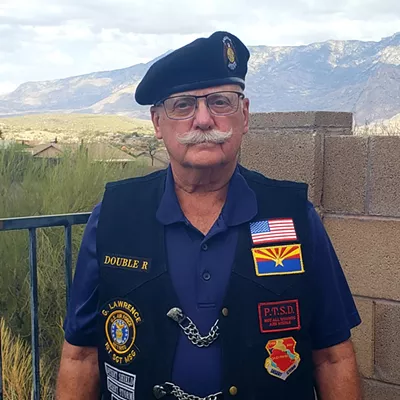Lisa Mele ponders her homeowners' insurance as she stands between a cracking wall and a buckling floor.
The longtime resident of downtown's Barrio Viejo finished renovating her old adobe home—"a labor of love," she calls it—just 10 years ago. Now she's watching the front part of that home fall to pieces.
Like the Rollings family, which owns numerous properties on the barrio's northern end (see "Barrio Blues," Currents, Feb. 24), Mele believes her historic Convent Avenue adobe home is a victim of the ancient, leaky cast-iron water mains still coursing beneath most barrio streets.
Telltale signs mirror those seen in the Rollings properties—widening ruptures in her concrete floor, patches of exterior wall peeling away, cracks zigzagging up her walls. And as with the Rollings buildings, all that damage is happening only on the side of her home nearest the water main.
"It's all in the front room," says Mele. "The rest of the house is fine."
When she raised her concerns with the city, "they said it was water damage from the rain," she says. "But this damage is coming from the inside out. My floors are disintegrating. The thresholds are crumbling from the inside out, and a crack comes across my patio into the house. Sometimes, the patio gets white from water residue, and I have to sweep it off."
Outside, she lifts the lid to a meter box sunk into the ground, and her fingers trace the damp soil inside.
The last time she contacted Tucson Water about this damage, she was referred to the City Attorney's Office. "Why are they asking me to call the city attorney when I have questions about the water lines?" she asks.
The key to information about this malaise is being tightly held by City Attorney Mike Rankin, who didn't return a phone call seeking comment for this story. Rankin has discouraged involvement in the matter by Jonathan Mabry, Tucson's historic preservation officer, and cautioned City Council members against meeting with the Rollings family. Nor did Mayor Bob Walkup return several phone calls seeking comment.
This wary stance dates to 2006, when Donald Rollings and his family sued the city of Tucson for more than $3 million, citing extensive damage on at least 15 of their barrio properties. The family is known for its long-running preservation efforts in the barrio, and in 2005, patriarch Kelley Rollings was honored with a Governor's Heritage Preservation Honor Award.
In 2006, the family lost their jury trial, only to see the verdict against them thrown out on appeal. They've since placed their case on hold, and hope to negotiate with the city.
But Tucson officials seem more willing to let the historic barrio crumble than admit any possible fault. They may fear that acknowledging problems with their century-old mains would open the floodgates to enormous liability claims dating back to at least 1999. That's the year Donald Rollings first filed a claim for the damage—a claim completely denied by the city's Risk Management Division.
A call to Risk Manager Joel Petersen was not returned.
Meanwhile, Tucson Water officials contend that rehabilitation work done on many of those mains in recent years—ostensibly cheaper than full replacement—has left the old lines in fine working order. "To the best of our knowledge, those mains aren't leaking," says spokesman Fernando Molina.
Instead, city officials blame faulty adobe-restoration techniques used by the Rollings family—despite the fact that damage occurs only near the mains.
Today, it's unknown whether Tucson Water will dig up any of its old water pipes to clear the air—and perhaps open a Pandora's box.
In the meantime, Molina says he hasn't heard about increasing concerns among Barrio Viejo residents beyond the Rollings family. "I'm not aware of any other people who have brought this up."
Sam Apichom lives in a 19th-century adobe on Meyer Avenue, just a block north of Mele. After buying the home about three years ago, he noticed the old wooden floor heaving upward in spots. So he removed it, compacted the soil below and put in a new brick floor.
"And in a matter of months, the heaving returned," Apichom says. "The front room has this obvious problem, with mounds here and mounds there."
He says the back rooms, redone at the same time, have suffered no damage at all.
Back on Convent, Mele is now organizing a neighborhood meeting to discuss the dilemma. Organization efforts have faced a hurdle, she says, because many residents are frightened to publicize their plight—and potentially send their property values reeling.
But Beth Jones, a Realtor who lives in the barrio and sells properties there, doesn't believe these suspected water problems will dampen values or squelch home sales. "My own properties are having those issues," she says. "But the impact is more about where we are in the economy."
Jones goes on to question the motives of those even raising this issue. In particular, she suggests that the Rollings family is simply trying to shake down the city. She adds that Donald Rollings once considered demolishing one of his buildings to make way for an RV park.
To Donald Rollings, that last allegation by Jones is a jaw-dropper. "It's sure the first I've heard of that," he says.
As for the money he's seeking from the city, Rollings says that sum doesn't even cover lost rents on many of his buildings, so damaged that they've been empty for the past decade. "As for that money, it's just lost," he says.
Instead, he suggests that Jones—whom the city sought to testify against him in court—doesn't quite grasp the extent of the damage to these timeless buildings. Or that true repair means hiring everyone from engineers and architects to soil specialists. "It's not just about cosmetics," he says.
At the end of the day, says Rollings, he just wants this precious part of Tucson's history preserved.
"Diminished property values are a factor," he says. "But paramount is the integrity of these special structures and the health of the neighborhood. In terms of our motivation, we keep it simple: Fix the mains, and fix the buildings."






